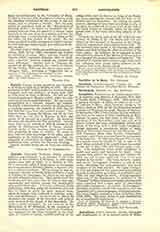

Castello, GIOVANNI BATTISTA, Italian painter, sculptor, and architect; b, at Gandino, in the Valle Seriana, in the territory of Bergamo, in 1509 (some writers state 1500 or 1506); d. at Madrid, in 1579. He is commonly called Il Bergamasco, to distinguish him from Giovanni Battista Castello, a Genoese, who was a miniature-painter. When young, he was entrusted to the care of Aurelio Busso of Crema, a pupil of Polidoro da Caravaggio, by whom he was taught the first principles of his art. That painter took him to Genoa, and after some time left him in that city, unprotected and without means, but considerably advanced in his studies. A Genoese nobleman, Tobia Pallavicino, took him under his protection and sent him to Rome to study the great masters there, where he became very proficient in painting, sculpture, and architecture. On his return to Genoa he decorated the palace of his protector and painted some frescoes in the church of San Marcellino. He made a great reputation by his painting of the Martyrdom of St. Sebastian, in the monastery of San Sebastiano and, together with Luca Cambiaso, was employed by the Duke Grimaldi, in the Nunziata di Portoria in Genoa, Castello painting on the ceiling of the choir the Savior as Judge of the World, and Luca painting the laterals with the Fate of the Blessed and the Reprobate. On visiting his native country, desiring to leave there something worthy of his fame, he undertook his great work in the hall of the Lanzi Palace at Gorlago, where he has represented some of the most interesting subjects of the Iliad.
Towards the latter part of his life (1567) he was invited by Philip II to visit Spain and was employed by that monarch in the palace of the Prado, which he ornamented with subjects from Ovid. He also executed some works in the Escorial and other palaces, and died holding the office of architect of the royal palace. As architect, he is supposed to have remodeled the church of San Matteo in Genoa and to have designed the imperial palace at Campetto. The paintings of Castello show correct design, with excellent coloring, more nearly allied, however, to the Venetian than to the Roman school.
THOMAS H. POOLE

